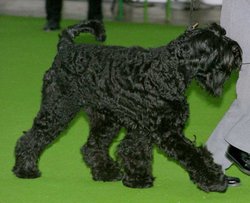
Russian Bear Schnauzer (early 1900s)
|
From Wikipedia the free encyclopedia, by MultiMedia |
| Giant Schnauzer | ||
|---|---|---|

Giant Schnauzer with
undocked tail (tentative identification)
|
||
| Alternative names | ||
| Riesenschnauzer Russian Bear Schnauzer (early 1900s) |
||
| Country of origin | ||
| Germany | ||
| Common nicknames | ||
| Classification and breed standards | ||
| FCI: | Group 2 Section 1 #181 | |
| AKC: | Working | |
| ANKC: | Group 6 (Utility) | |
| CKC: | Group 3 - Working Dogs | |
| KC (UK): | Working | |
| NZKC: | Utility | |
| UKC: | Herding | |
| Not recognized by any major kennel club | ||
| This breed of Dog is extinct | ||
| Notes | ||
The Giant Schnauzer is a large, powerful, compact breed of Dog. It is one of several Schnauzer breeds. It is a fairly large breed which needs a lot of exercise, making it unsuitable for owners who don't have time for long walks.
The Giant Schnauzer has a harsh, wiry outer coat and dense, soft undercoat. Coat color is typically black but can also be pepper-and-salt. It weighs between 70 and 99 lb (32-45 kg) and stands 23.5 to 27.5 in (59 to 70 cm) at the withers.
When moving at a fast trot, a properly built Giant Schnauzer will single-track. Back remains strong, firm, and flat.
The Giant Schnauzer is a large, powerful, dominant Dog which needs a firm and consistant handler. It also needs a tremendous amount of exercise to prevent it from becoming bored and destructive.
Early and consistent training is necessary as the Giant Schnauzer tends to be obstinate and very willful. Its ability to understand a command doesn't always translate into obedience.
They can become Dog aggressive as they mature. If you are thinking of adding a second Dog to your family, it's best to get a puppy or rescue of the opposite gender.
This breed used to be generally hardy; however, recently more auto-immune diseases have cropped up in this breed. Arthritis does occur in shoulders or hips. Its life expectancy is about 11 or 12 years. Before buying or adopting a Giant Schnauzer one should consider if he or she is able to afford potential expensive vet bills.
Other health problems in the breed include:
The breed originated in the Middle Ages in Germany by selectively breeding the Standard Schnauzer for larger and larger sizes. In earlier centuries it was a popular herding breed, but its need for more food than some breeds made it less popular for farmers on tight budgets or with limited resources.
Its popularity grew again in the latter part of the 19th century, when it was used as a drover and as a guard Dog.
Dogs, made by MultiMedia | Free content and software
This guide is licensed under the GNU Free Documentation License. It uses material from the Wikipedia.